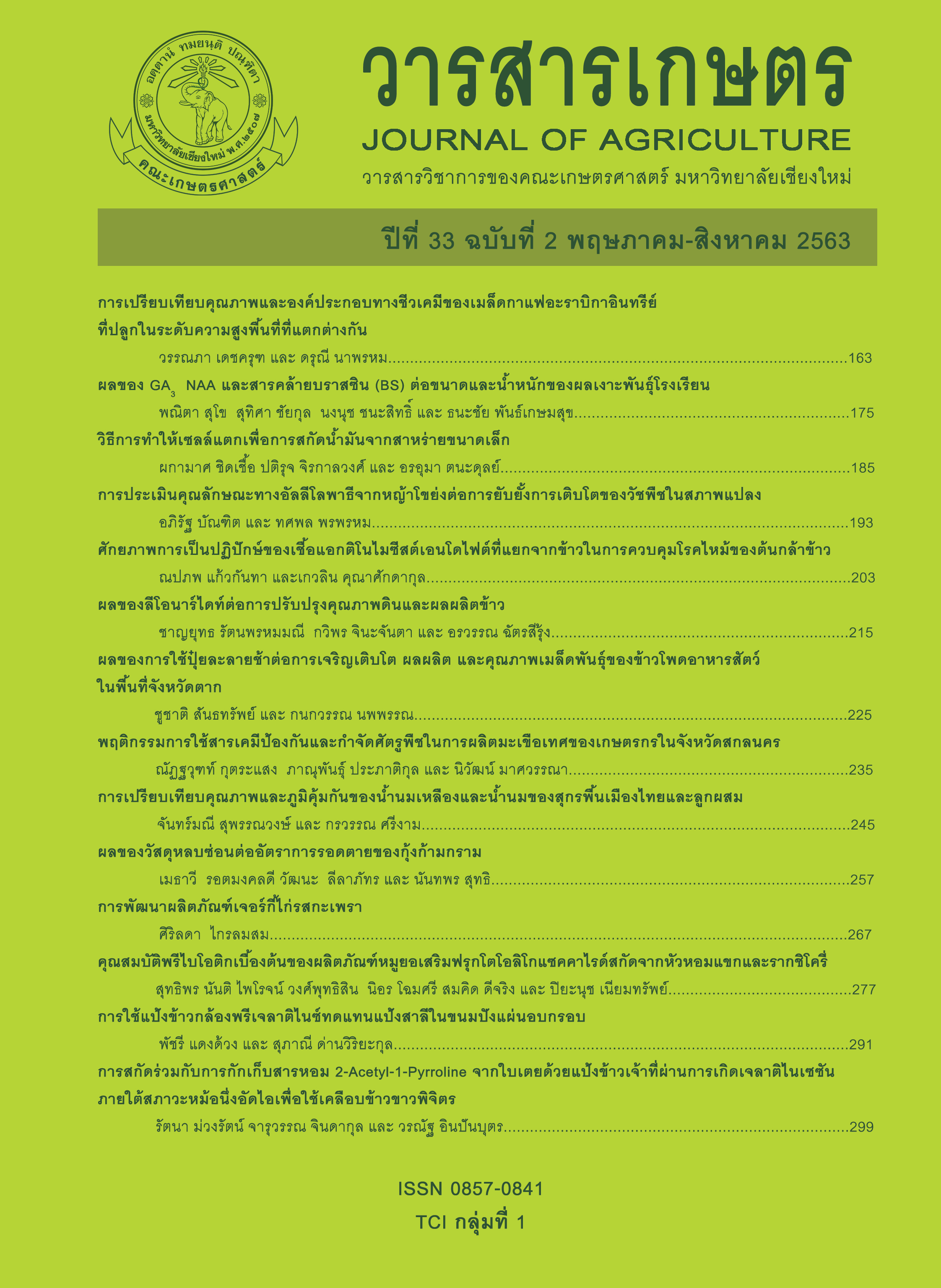การประเมินคุณลักษณะทางอัลลีโลพาธีจากหญ้าโขย่งต่อการยับยั้งการเติบโต ของวัชพืชในสภาพแปลง
Main Article Content
บทคัดย่อ
เกษตรกรในเขตพื้นที่ อ.แจ้ห่ม จ.ลำปาง ภาคเหนือของประเทศไทย ได้มีการนำหญ้าโขย่งมาใช้ในลักษณะของการคลุมด้วยหญ้า เพื่อควบคุมวัชพืชในแปลงปลูกพืชผัก จึงได้ทำการศึกษาคุณลักษณะทางอัลลีโลพาธีจากหญ้าโขย่งในสภาพแปลงเกษตรกรที่มีการใช้หญ้าโขย่งควบคุมวัชพืช โดยทำการประเมินคุณลักษณะทางอัลลีโลพาธีของหญ้าโขย่งต่อความหนาแน่นจำนวนประชากรวัชพืชพวกกก พวกหญ้า และใบกว้าง รวมทั้งได้ทำการทดสอบคุณลักษณะทางอัลลีโลพาธีของดินที่ใช้หญ้าโขย่งในการควบคุมวัชพืชต่อการเติบโตของพืชทดสอบบางชนิด พบว่า ในสภาพแปลงเกษตรกรที่ใช้หญ้าโขย่งควบคุมวัชพืช มีการควบคุมวัชพืชได้ดีกว่าแปลงที่ไม่มีการใช้หญ้าโขย่ง จะเห็นได้ว่า การใช้หญ้าโขย่งในลักษณะของการคลุมด้วยหญ้า ส่งผลทำให้ความหนาแน่นของประชากรวัชพืชในแปลงปลูกพืชผักลดลง การศึกษาคุณลักษณะทางอัลลีโลพาธีของหญ้าโขย่งในดินต่อการยับยั้งการเติบโตของพืชทดสอบ พบว่า ดินที่ใช้หญ้าโขย่งมีผลยับยั้งการเติบโตของพืชทดสอบบางชนิด ได้แก่ ก้นจ้ำขาวดอกใหญ่ และหญ้าข้าวนก เป็นต้น นอกจากนี้ เมื่อวิเคราะห์คุณสมบัติทางกายภาพและเคมีของดินระหว่างดินที่ใช้และไม่ใช้หญ้าโขย่งควบคุมวัชพืช พบว่า ไม่มีความแตกต่างกันอย่างชัดเจน อย่างไรก็ตาม ดินที่มีการใช้หญ้าโขย่งมีปริมาณอินทรียวัตถุมากกว่าดินที่ไม่ใช้หญ้าโขย่งควบคุมวัชพืช แสดงให้เห็นว่า หญ้าโขย่งมีคุณลักษณะทางอัลลีโลพาธีที่มีผลต่อความหนาแน่นและการเติบโตของวัชพืชในสภาพแปลงปลูกพืช ดังนั้น กิจกรรมทางอัลลีโลพาธิคของหญ้าโขย่งจะเป็นข้อมูลที่สำคัญในการควบคุมวัชพืช เพื่อลดการใช้สารป้องกันกำจัดวัชพืชในระบบการเกษตรแบบยั่งยืนต่อไป
Article Details
References
ทัศนีย์ อัตตะนันทน์ และ จงรักษ์ จันทร์เจริญสุข. 2542. แบบฝึกหัดและคู่มือปฏิบัติการ การวิเคราะห์ดินและพืช, ภาควิชาปฐพีวิทยา คณะเกษตร มหาวิทยาลัยเกษตรศาสตร์, กรุงเทพฯ. 108 หน้า.
ปัณรสี สู่ศิริรัตน์. 2559. ประสิทธิภาพของสารสกัดจากเปลือกว่านหางจระเข้ในการควบคุมหนอนใยผัก. วารสารเกษตร 32(3): 369-378.
ปิลันธนา ฐาปนพงษ์วรกุล และ ชนากานต์ รัตนศักดิ์ชัยชาญ. 2559. ประสิทธิภาพของน้ำสกัดชีวภาพจากเศษเหลือพริกต่อการยับยั้งเชื้อรา Colletotrichum gloeosporioides ในสภาพห้องปฏิบัติการ. วารสารเกษตร 32(1): 61-72.
Alloub, H., A.S. Juraimi, A. Rajan, J. Kadir, M.S. Saad and S. Sastroutomo. 2005. Growth behavior of itchgrass (Rottboellia cochinchinensis) in Peninsular Malaysia. Weed Biology and Management 5: 8-13.
Barnes, J.P. and A.R. Putnam. 1987. Role of benzoxazinones in allelopathy by rye (Secale cereale L.). Journal of Chemical Ecology 13: 889-906.
Casini, P., V. Vecchio and I. Tamantini. 1998. Allelopathic interference of itchgrass and cogongrass; Germination and early development of rice. Tropical Agriculture 75: 445-451.
Dalton, B.R., U. Blum and S.B. Weed. 1983. Allelopathic substances in ecosystems. Journal of Chemical Ecology 9: 1185-1201.
Duke, S.O. 2015. Proving allelopathy in crop–weed interactions. Weed Science 63(sp1): 121-132.
Hall, D.W. and D.T. Patterson. 1992. Itchgrass: stop the trains?. Weed Technology 6: 239-241.
Inderjit. 2002. Allelopathic effect of Pluchea lanceolata on growth and yield components of mustard (Brassica juncea) and its influence on selected soil properties. Weed Biology and Management 2: 200-204.
Kobayashi, K. 2004. Factors affecting phytotoxic activity of allelochemicals in soil. Weed Biology and Management 4: 1-7.
Kobayashi, K., D. Itaya, P. Mahatamnuchoke and T. Pornprom. 2008. Allelopathic potential of itchgrass (Rottboellia exaltata) powder incorporated into soil. Weed Biology and Management 8: 64-68.
Lejeune, K.R., J.L. Griffin, D.B. Reynolds and A.M. Saxton. 1994. Itchgrass (Rottboellia cochinchinensis) interference in soybean (Glycine max). Weed Technology 8: 733-737.
Lencse, R.J. and J.L. Griffin. 1991. Itchgrass (Rottboellia cochinchinensis) interference in sugarcane (Saccharum sp.). Weed Technology 5: 396-399.
Meksawat, S. and T. Pornprom. 2010. Allelopathic effect of itchgrass (Rottboellia cochinchinensis (Lour.) W.D. Clayton) on seed germination and plant growth. Weed Biology and Management 10: 16-24.
Millhollon, R.W. and D.M. Burner. 1993. Itchgrass (Rottboellia cochinchinensis) biotypes in world populations. Weed Science 41: 379-387.
Mushtaq, M.N., Z.A. Cheema, A. Khaliq and M.R. Naveed. 2010. A 75% reduction in herbicide use through integration with sorghum + sunflower extracts for weed management in wheat. Journal of the Science of Food and Agriculture 90: 1897-1904.
Norsworthy, J.K. 2003. Allelopathic potential of wild radish (Raphanus raphanistrum). Weed Technology 17: 307-313.
R Development Core Team. 2009. R: a language and environment for statistical computing, (Online). Available: http://www.R-project.org (February 10, 2015).
Strahan, R.E., J.L. Griffin, D.B. Reynolds and D.K. Miller. 2000. Interference between Rottboellia cochinchinensis and Zea mays. Weed Science 48: 205-211.
Tet-Vun, C. and B.S. Ismail. 2006. Field evidence of the allelopathic properties of Dicranopteris linearis. Weed Biology and Management 6: 59-67.
Tongma, S., K. Kobayashi and K. Usui. 2001. Allelopathic activity of Mexican sunflower [Tithonia diversifolia (Hemsl.) A. Gray] in soil under natural field conditions and different moisture conditions. Weed Biology and Management 1: 115-119.
Walkley, A. and I. A. Black. 1934. An examination of the Degtjareff method for determining soil organic matter and a proposed modification of the chromic acid titration method. Soil Science 37: 29-38.

